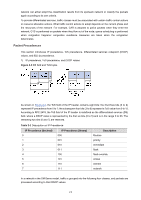3Com 2928 User Guide - Page 462
Causes, Impacts, Countermeasures
 |
UPC - 662705557113
View all 3Com 2928 manuals
Add to My Manuals
Save this manual to your list of manuals |
Page 462 highlights
Causes Congestion easily occurs in complex packet switching circumstances in the Internet. The following figure shows two common cases: Figure 2-1 Traffic congestion causes 100M 100M 10M 10M 100M 100M>10M (1) 50M (100M+10M+50M)>100M (2) z The traffic enters a device from a high speed link and is forwarded over a low speed link. z The packet flows enter a device from several incoming interfaces and are forwarded out an outgoing interface, whose rate is smaller than the total rate of these incoming interfaces. When traffic arrives at the line speed, a bottleneck is created at the outgoing interface causing congestion. Besides bandwidth bottlenecks, congestion can be caused by resource shortage in various forms such as insufficient processor time, buffer, and memory, and by network resource exhaustion resulting from excessive arriving traffic in certain periods. Impacts Congestion may bring these negative results: z Increased delay and jitter during packet transmission z Decreased network throughput and resource use efficiency z Network resource (memory in particular) exhaustion and even system breakdown It is obvious that congestion hinders resource assignment for traffic and thus degrades service performance. Congestion is unavoidable in switched networks and multi-user application environments. To improve the service performance of your network, you must address the congestion issues. Countermeasures A simple solution for congestion is to increase network bandwidth, however, it cannot solve all the problems that cause congestion because you cannot increase network bandwidth infinitely. A more effective solution is to provide differentiated services for different applications through traffic control and resource allocation. In this way, resources can be used more properly. During resources allocation and traffic control, the direct or indirect factors that might cause network congestion should be controlled to reduce the probability of congestion. Once congestion occurs, resource allocation should be performed according to the characteristics and demands of applications to minimize the effects of congestion. 2-2















